Equipment: Paints
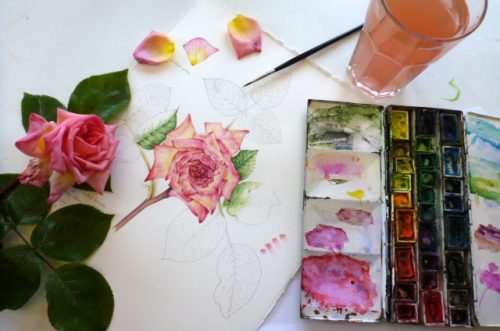
Equipment: Paints is another in my series about materials and equipment used for creating botanical and natural history illustrations. Check out my blogs on which watercolour paper to use, pencils and erasers, and a review of waterproof inks. Future blogs in this series will include one on my paintbrush of choice, one on science stuff you might need, and one focussed on pencils and rubbers. As with the other blogs, I stress that what materials you use van be a very personal choice, and you often end up evolving with the equipment you learn to use first.
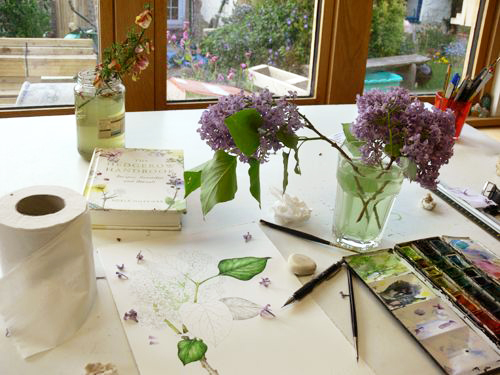
Illustrating Lilac Syringa vulgaris
First using watercolours
When I first used watercolour, I used my Mum’s paint-box. She was a fine artist, so had lots of posh art equipment which she always encouraged us children to use. Her paints (a selection of browns, greys, and ochres as her subject matter tended to be broken industrial landscapes and cemeteries) were Winsor and Newton.
My first paint-box, was bought by my parents for my 10th birthday. It was a lovely tin full of Winsor and Newton pans and half pans. I used this until 2015, topping it up and switching in new pans.
My current watercolour paint-box
Finally the white enamel cracked from the palette. The tiny paint flakes kept getting mixed in with my colours. I had to replace the box itself, and I really struggled. The mixing palettes are lovely, deep, and what I was used to! Eventually I found a stockist of the empty tins, Green and Stone. My quest was over.

My current paint-box (not in any way cleaned for its photo-op, I’m afraid)
As you can tell from the photo, it’s very much a working tool and is quite often shamefully grubby. This is important, and should be avoided. Having dirty pans of colour will effect the colours you paint with. It’s an ongoing fight to try and keep my yellows clean. I mostly lose.
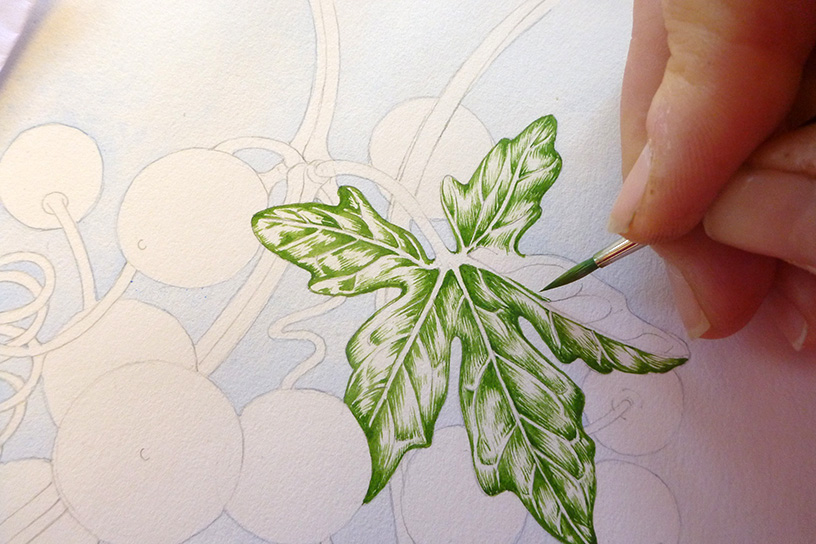
Illustrating a Bryony leaf Bryonia dioica for Jersey Post
Watercolour pans
Watercolour comes in tubes or in pans. I like the pans; it’s so quick to open the box and start painting. Pans come in full, or half sizes. When the pans become empty, I fill them up with paint from tubes. This is frowned on, someone told me the paint is a different composition and the two shouldn’t be mixed. It’s never been a problem for me, but I am willing to listen to reasons why it’s inadvisable.

Paints in pans from my back-up watercolours box. Most are Winsor and Newton, many used.
The paint in the pans is dry, and this is a clear difference between the tubes and the pans. However, the colours seem to be identical.
The main trick with paint mixing is to make notes of the colour mixes that you use, so you can re-create them later. You can do this as a swatch (as on the side of the painting on the illustration below) or in written form.
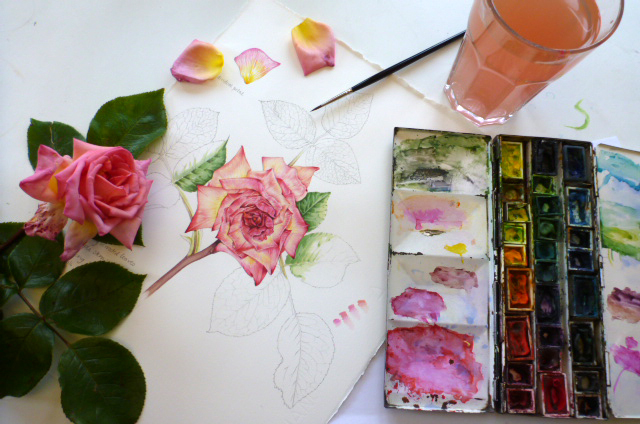
Illustrating a rose
Watercolour tubes
I have lots of these tubes. I tend to buy them up when I’m in an art shop and see them on sale, so have lots of duplicates and different sizes.
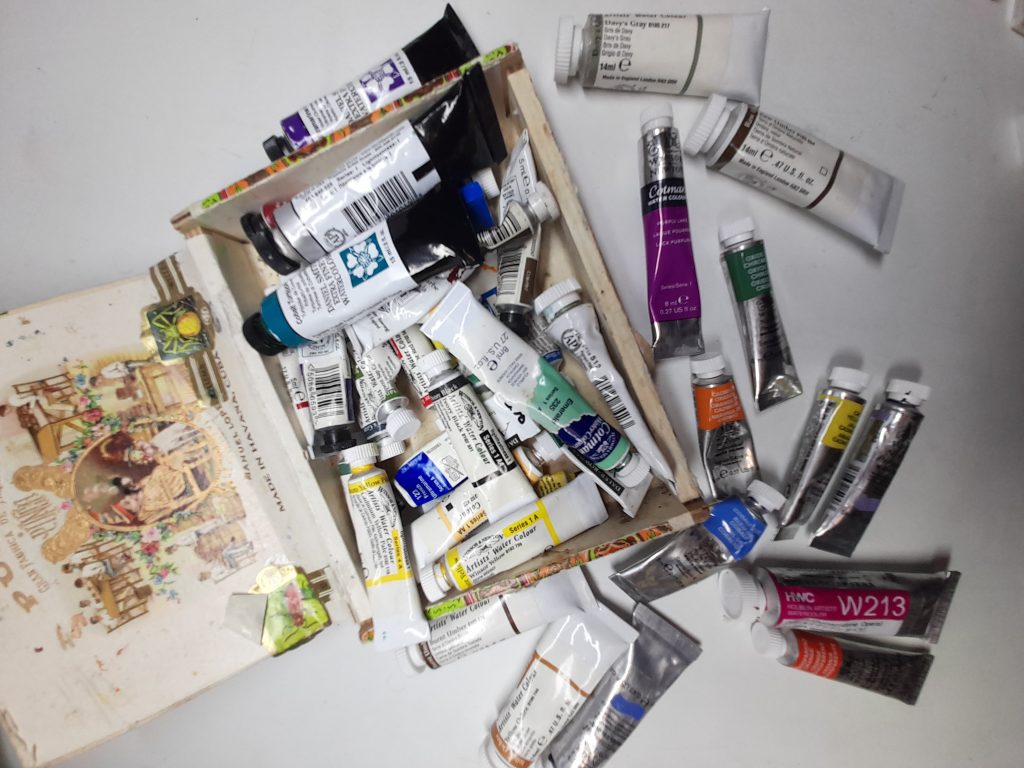
Equipment: paints: My watercolour tubes, which nominally fit into an old cigar box (they don’t fit).
Sometimes I’ll use a blob of pure watercolour and paint from it, this is mostly if I’m tackling the sky of a big landscape (Cobalt blue is good for skies). In general, though, I simply use the tubes to top up the pans in my paint-box.
The brand I favour is Winsor and Newton. I tend to use their professional watercolours, but their Cotman range is good too. They’re clean, strong colours, and don’t go grainy. Some of my W&N tubes date back 30 years or more, and the colours seem as true as the newly purchased tubes.
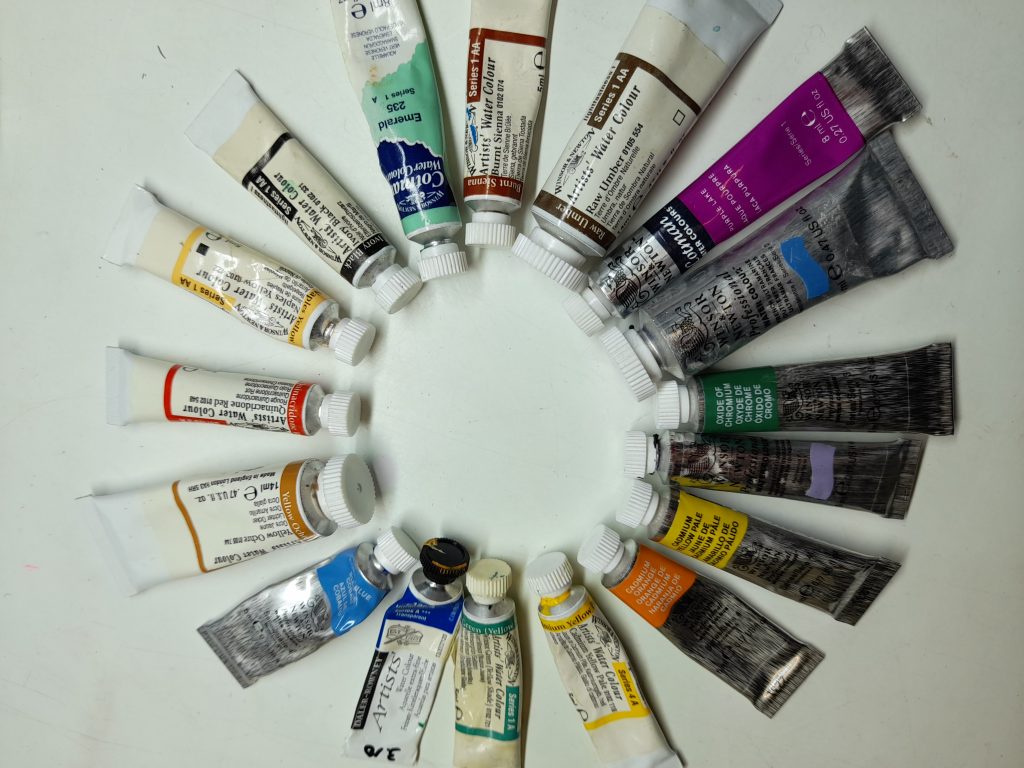
Some of my Winsor and Netwon tube watercolours
Sometimes I’ll put a spot of tube paint on one of the paint-box dishes, I’ve recently started doing this with Daniel Smith’s Spring Green which is a good base for mixing up realistic green hues.
The ones I use most of are the yellows. Cadmium yellows, Naples yellow, and Yellow ochre. This is because these get mixed up into every single green I use, and as they’re weaker colours than the blues and greens in the mix, I need to use proportionally more of them.
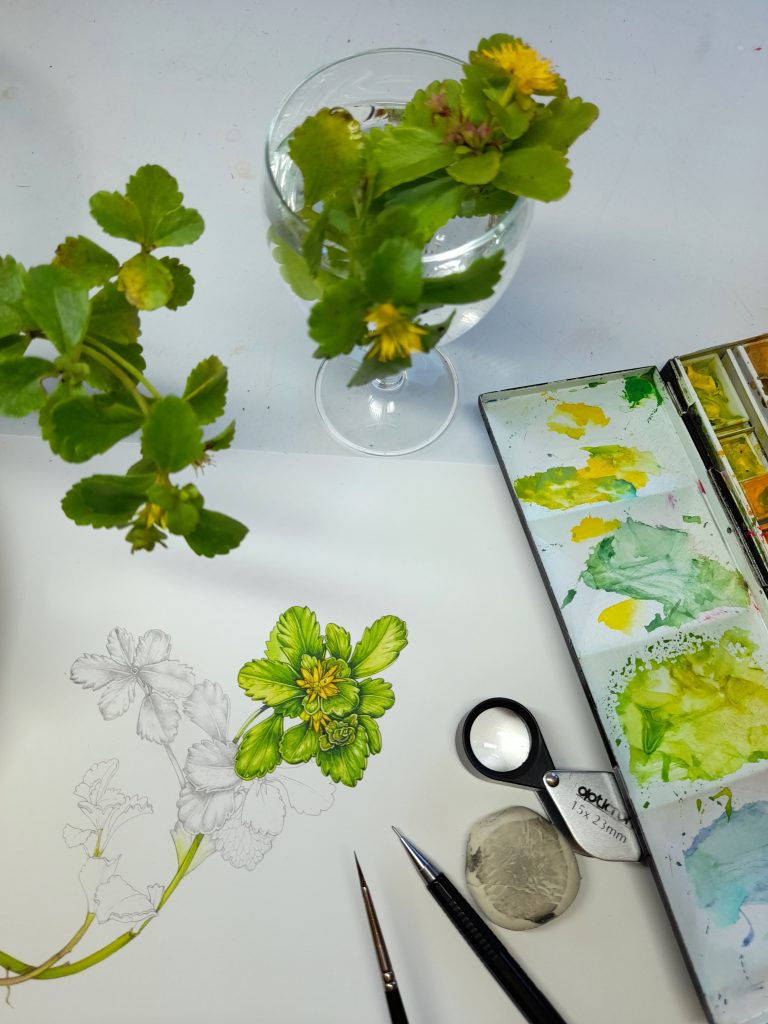
Illustrating Mongolian stonecrop Phedimus hybridus . You can see the heavy use of yellows, and that blob of Spring Green in the top right of the palette.
Learning your paints and your paint-box
Sometimes I make the error of filling up a half empty pan with a rather different hue, and this isn’t a great idea. Topping up a yellowish Sap green with a very blue Phthalo green was a memorable error. Saying that, it actually made for rather a handy colour, the two worked well together.
I tend to mix, and go on mixing until it looks right.
You learn your way around your paint box. As the years go by you end up knowing what different colours look like, both in your paint-box and fresh from the pan or tube.
Why I can be vague on my colour mixes…
This somewhat slap-dash approach to my paints is why I sometimes find it difficult to give precise answers if asked what colours I use for a specific illustration. Often the labels on the pans have rubbed off or are illegible. Remembering what colour I topped up with a few months ago is often beyond me. Sometimes (especially if I don’t to take notes) I simply forget.
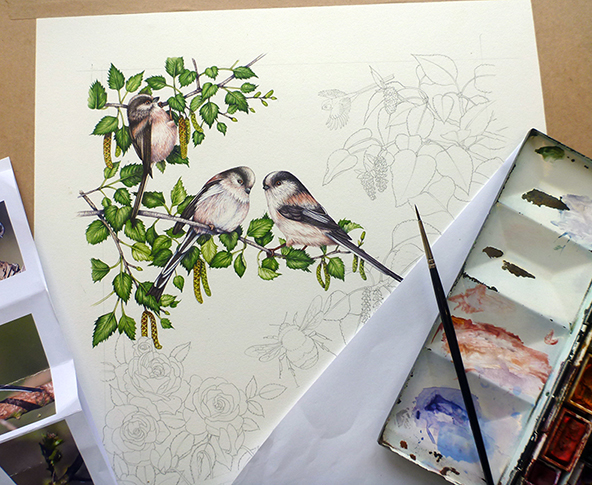
Long tailed tits in progress.
I am aware this lackadaisical approach might horrify some professional and amateur botanical illustrators, and that’s totally understandable. But I do think that sometimes people get tangled up in the details of brands and colours when they’re starting out. Knowing more or less what each colour looks like, and how it mixes is great. But if choosing the correct exact named hues becomes an obsession, or a barrier to just getting out some paints and experimenting, then I’m not sure how useful it is. Perhaps I’m speaking from the luxurious position of someone whose been lucky enough to have the time to learn her paint-box and colours inside out; with less time available knowing names and brands could be more important?
Other Brands of Watercolour paint
Alongside Winsor and Newton, I use other brands of paint. After hearing lots of recommendations, I purchased some Daniel Smith “dot cards”. I figured they’d be a good way to test the different colours without committing to a whole (pricey) tube of paint. I ended up painting from them, until I wore through the paper the dots were on, alongside my normal paint-box. I wish I’d taken a photo of the used cards, they were rather pretty.
Eventually, I decided to buy a few tubes, which I use a lot. My most used is the Spring green. It’s a brutal colour fresh from the tube, but mixed with purples, ochres, blues and yellows; it makes for a beautiful and adaptable hue.
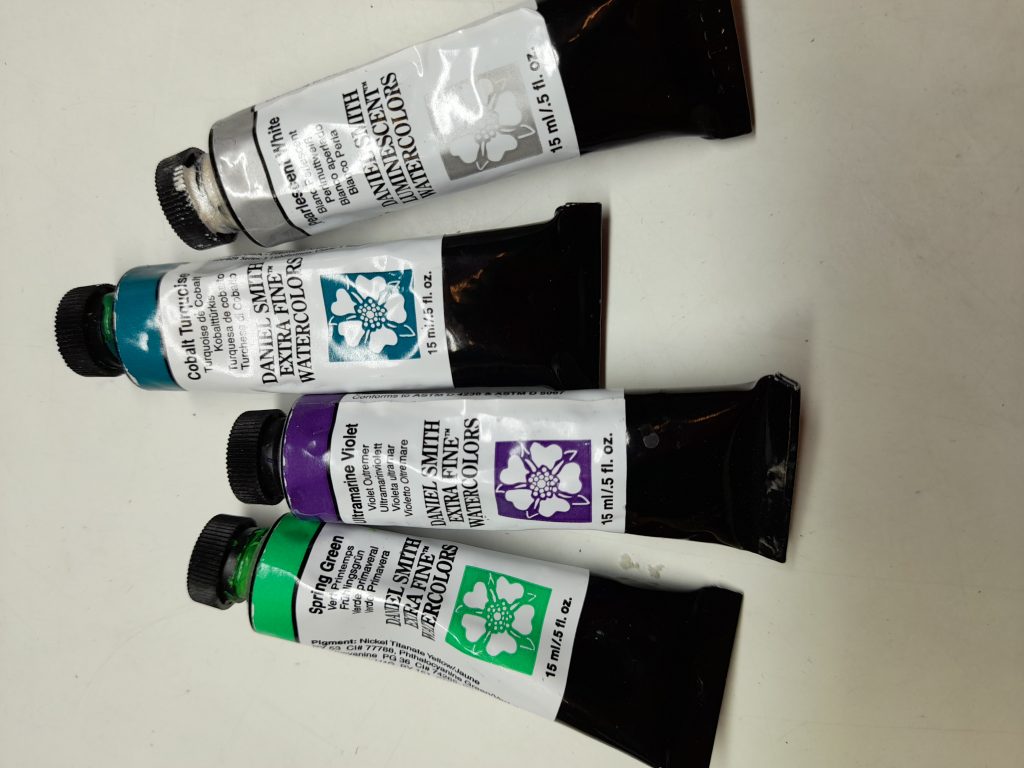
Daniel Smith tubes
I also use Daler Rowney on occasion, and have become extremely attached to Doctor Martin’s Hydrus inks. these transparent colours are almost violent in their vividness, and are incredibly useful. I mix them in with my watercolours and they give an extra punch that helps emulate the bright colours of nature. The colour I use most is their Quniacridone magenta, perfect for mixing up to capture pink flowers.
Doctor Martin’s inks – perfect for the pink of a cyclamen
Other brands of watercolour paint I’ve heard about from other botanical illustrators include: Sennelier, St. Petersburg White nights, Talens: Rembrandt, Shinhan, Holbein, Schminke, and Old Holland. I’d love it if anyone who uses and adores these ranges felt like giving a bit of a review in the comments section.
Pink flowers and Opera pink watercolour
When it comes to pink flowers, along with the Dr. Martin’s magenta, I use plenty of Opera rose. Now, although this is a fabulous colour, it is notoriously awkward as it’s known to fade. Artists have tested it’s lightfastness, with varying results (Jane Blundell, and an interesting post on whether or not watercolour paints DO fade from Lee Angold.)
Lots of pigments fade with time, and watercolours are prone to become paler. Some pigments fade more than others. The pinks and purples and reds are most fugitive (prone to fading). You can avoid this by having framed work behind conservation glass (or museum glass), and by keeping original watercolours away from direct sunlight. It can be a problem though. I once painted a Purple emperor butterfly, and put it in the window of a gallery. Within 6 weeks the butterfly had faded to a tawdry (and entirely un-saleable) brown colour.
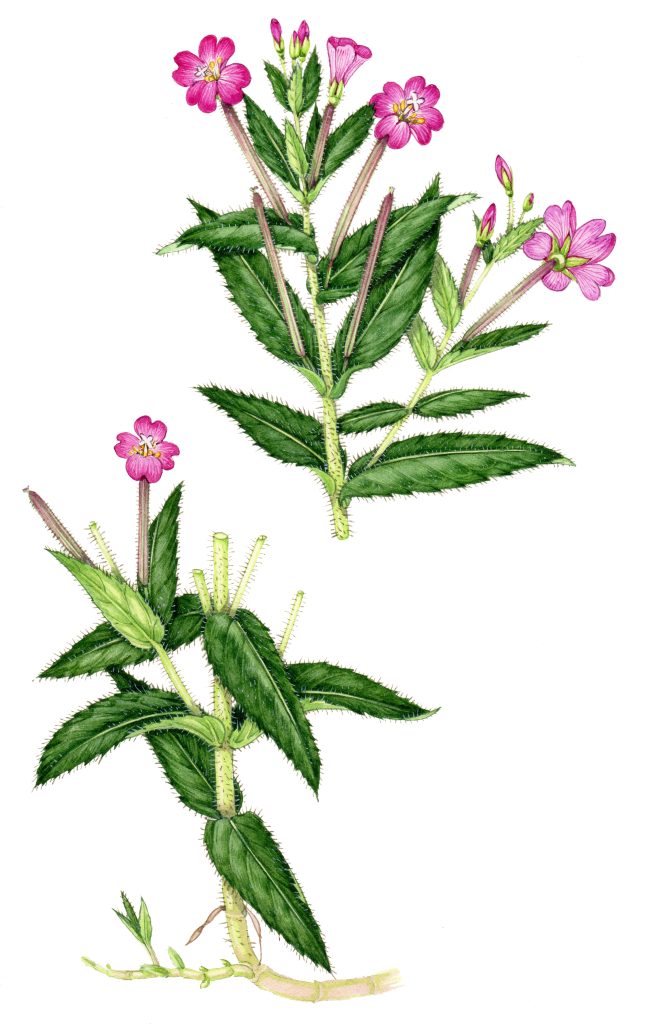
Greater willowherb Epibolium hirsutum
This is less problematic is you’re creating work for reproduction rather than for exhibition, but it’s worth remembering. I bought up a batch of Opera rose from different companies recently; I’m interested to know which brand I end up liking most. I’m not alone in this. There’s a lot of online chat about opera rose, including rather a nice comparison of different brands video on Youtube.

Opera rose paints from Jackson’s, Winsor and Newton, Holbein, and the W&N in pan form.
One more paint…and it’s Gouache!
This last paint is for fixing mistakes. I avoid using it on work I plan to sell, but for work that’s going to be reproduced, it can be a life saver. Permanent white gouache. You mix it to a thick consistency, then paint over smudges and mistakes. It’s easy to blend in with the white of the paper. Avoid touching it until it’s dry, it’ll clump and lift the colour from underneath. Actually, don’t touch it when it IS dry either, the grease on your hands may dull the white. It’s also really useful for adding delicate white hairs against a dark leaf, and it’s an important part of my tool kit.
In the plate below, done for HarperCollins Flower Guide, you can see how white gouache was used to remove the upper leaves of the Dune gentian. This adapted plate went to repro with no quibbles. (For more on mixing mistakes in watercolour, check out my earlier blog).
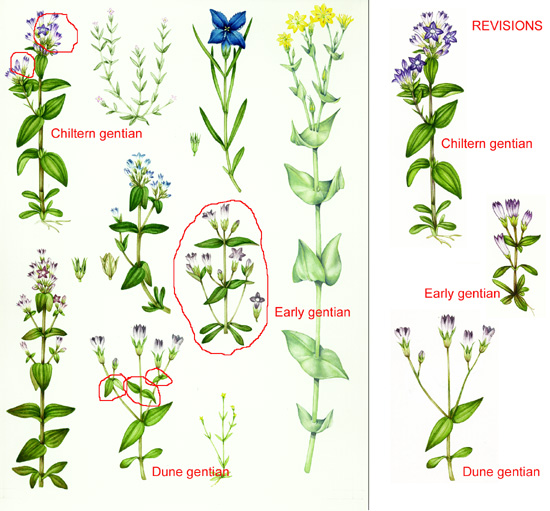
Gentian plate with alterations circled in red
I use this paint quite thick, and it’s important to thoroughly rinse the paint-box and brush when you’re finished with it or it’ll make all your watercolours paler and chalky.
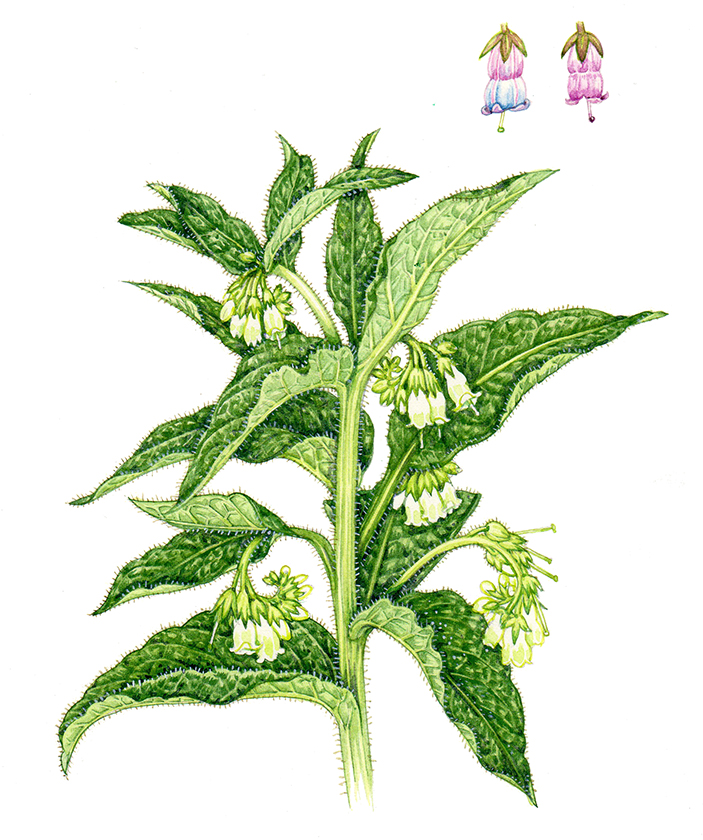
Common comfrey Symphytum officinale with hairs on the stem picked out with white gouache
Conclusion
If you’re looking for comparisons of different brands of watercolour paint, there’s a whole lot of really interesting blogs and youtube videos online. For me, my lifelong relationship with Winsor and Newton continues unabated. They’re easy to come by, good strong colours, not prohibitively expensive, comparatively lightfast, and I love them.
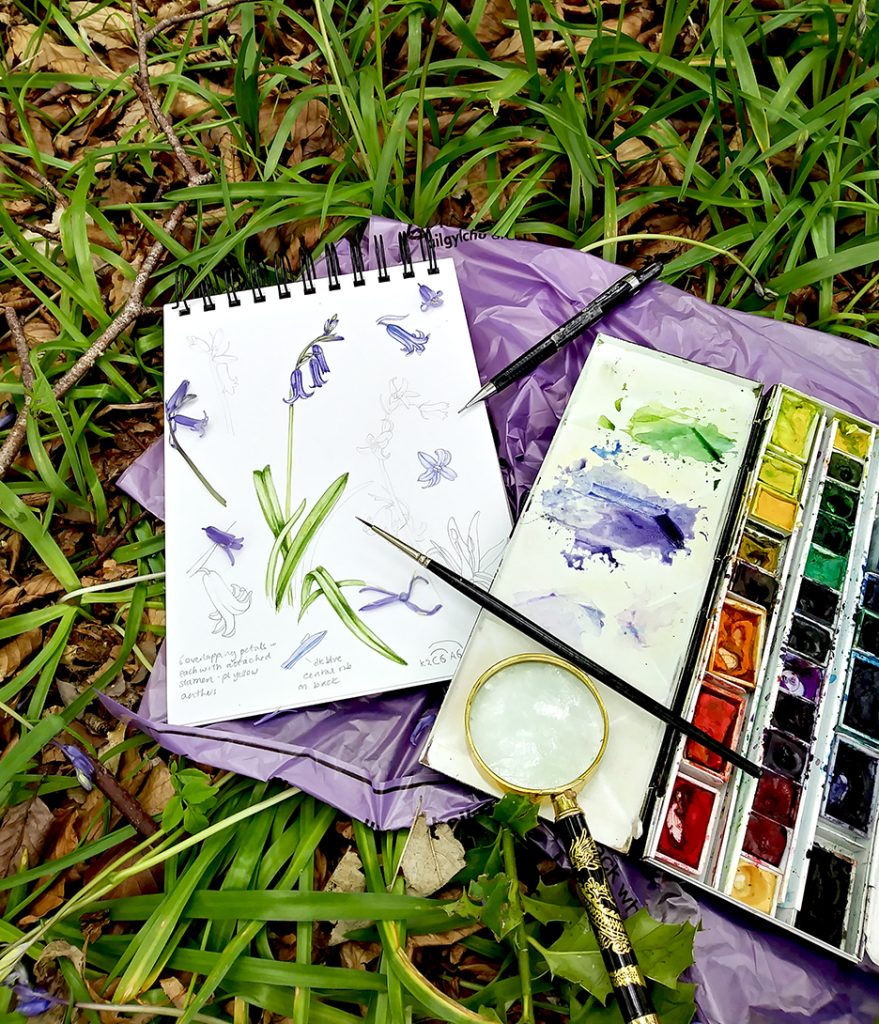
…and you can easily take a paint-box into a bluebell wood!
Most of the materials and paints mentioned in this blog are readily available from art stores. I try to shop local, but if that’s not possible, then I buy from UK suppliers such as Jackson’s, Cass Art, London Graphics Centre, and Ken Bromley. I try to avoid the big online sellers even though they’re sometimes cheaper; it’s my (tiny) way of supporting the art stores that support me. In the US, I believe Dick Blick is a good shop, and sells online.


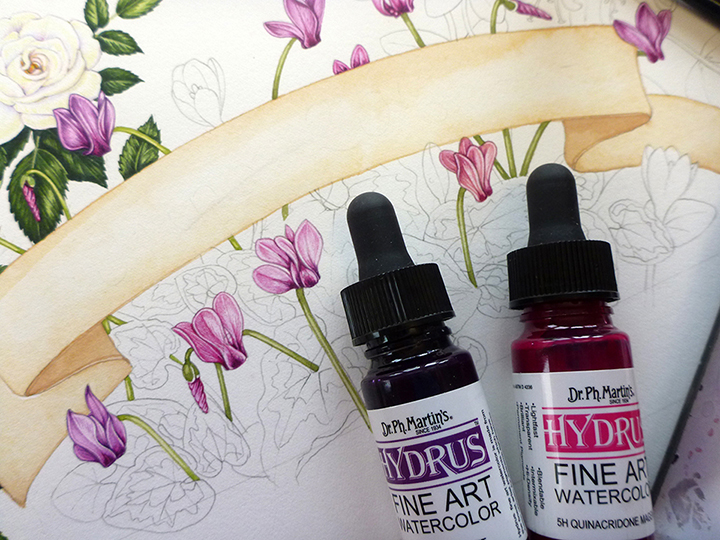
Thanks for the education Lizzy, always interesting to read about the thoughts of others regarding their paint choices.
I love the artwork shown here, especially the birds but all of your work is always lovely to look at.
Looing forward to your next blog.
E
Thanks E. Yeah, I love painting birds, but recently it’s mostly been botanical. And ants, of course! Thanks for leaving a comment, and for your ongoing kindness. x
Thanks Lizzie for sharing.
My pleasure, glad you enjoyed it. x
Love this blog post Lizzy !
Regarding Opera Rose, when I did the Watercolour Lightfastness tests, I tested 3 Opera Rose paints, W&N Opera PR122, Turner Opera BV11+Pr122, Sennelier Opera PR81:1, I didn’t have enough Daniel Smith Opera PR122 on the dot card to make a swatch for testing.
The W&N Opera PR122 was the only one to not fade completely, it held up to Blue Wool Scale 6-7 with only slight fading, hopefully being the same pigment, the Daniel Smith Opera will be as good.
Dearest Polly, I should have REMEMBERED you’d done those exhaustive colour swatches. This is super-useful. Glad to hear W&N are the least fade-y, I rely on them. Thanks a million for this. x
Hi Lizzie, I’m very happy to read that you mix colours in the same way I do. When I want to paint a flower I try different colour mixes to achieve the right colour, but I don’t write the pigments. I don’t like the colour charts, the only one I prepared is the chart of greens. Which are the most difficult colours to mix? I think oranges. Now I have to find the right pale yellow and the dark purple-red for a calicanthus flower. And I love the spontaneous photos of your ‘dirty’ palette. I don’t like the ‘perfect’ world of Instagram. And yes, I tried many brands, but Winsor and Newton are brilliant and fresh.
Hi Simonetta, sounds like you’re a woman after my own heart. I only take notes so I can re-mix if I need to, but the swatches thing is something I’ve not really got my head around. I bet if I DID do swatches my whole life would be simpler, but I just don’t have time. Or know where to begin. I agree about oranges, cause so many colours you add just make them brown or muddy. Even worse than the yellows, wierdly. Wow, your Calicanthus sounds like it’ll be a stunner. And I know, instagram makes me laugh. Everyone is smooth-skinned and gorgeous, and their paintboxes are effortlessly spotless, and they NEVER spill tea or crush aphids onto their work! I’m glad you’ve noticed too! Lovely to hear your comment, and thanks X
Loved this article about the way you mix your colors as it’s similar to how I work. I think I have the same “lackadaisical “ approach to mixing my colors as you. Perhaps it because I have years of experience with color, and for me it’s almost instinctual if I need to add a bit of blue or red or yellow. So I don’t make a lot of notes about what colors I’m mixing with what. So when people ask the question such as which is your favorite blue or favorite red etc, , or what is my method or “ recipe” for mixing a color I often can’t give a precise answer! When I worked years ago as a textile designer I worked in gouache and had to match all colors to the Pantone scale, in those days I did keep notes , when mixing color, as I would often have to replicate a particular color for a co-ordinating design.
So my advice that usually give people new to painting, is learn color! Learn how colors work with each other and experiment to see how they work together. Eventually you get comfortable with color and know how to work with it!
Thanks for a fun article,
Donnett
Hi Donnett
I think youve hit the nail on the head. When you’re in amongst colour mixing all the time it feels so obvious, second nature. But yes, for people starting out it really must be harder. That’s interesting about matching textile colour to pantone, maybe a good task for someone starting out with mixing colours would be to take a few random pantones and match to them as close as possible, making notes of what they used on the way? But as you say, I think it’s one of those things you learn on the job. How interesting that you feel the same as I do. I guess we’re just so lucky to have jobs where mixing up colour is such an integral part of it all that we end up doing it without thinking! Thanks for the comment, food for thought. x
Hello, Lizzie,
I have recently retired and my leaving present was a box of Sennelier watercolours. My ambition now is to learn how to paint wild flowers. Having found your website has thrilled me no end, hopefully I will be able to create reasonable paintings with some guidance from your blogs. Thank you.
Hi Trish
How exciting for you! Do keep at it, it’s like learning a foreign language. The more you immerse yourself and do it, the better you get. Let me know how you get on with Sennelier, Ive never tried them myself but have heard really good things about them. Enjoy your retirement, and your walks finding the wildflowers that you’ll be illustrating. What a lovely way to spend time. x
Hi Lizzie and thank you for this interesting post.
I’ve stopped using gouache for corrections and highlights and I switched to the Kuretake Zig 30 White Ink. This is an extra opaque white acrylic paste that you can disolve it with water for use with brush or dip pen. It is great for corrections because it is more opaque than gouache, it is mat, it is waterproof after drying and you can glaze over it. That glazing property that it has, allows you to make super complicated and tiny details ( even with a dip pen) on top of your watercolours and then glaze them to match with the rest of the painting. This way you don’t have to use masking fluid or paint arround the whites you want to preserve.
As this ink is waterproof and prevents paper from sucking the paint you can also use it as an alternative to masking fluid under the condition that you remember where you applied your watercolours over the ink in order to remove them afterwards, without that much try as the watercolours sit on top of the acrylic masking ink. You can also highlight further with it the already preserved highlights and so boost the contrast of your illustration. This is something that I often do. I highlight the already preserved on extra white paper highlihts.
The only minor disadvantage of this ink is that it is extra white and so it is not suitable for beige or cream watercolour papers. If you use beige papers then you have to bring it to a colour close to that of you paper by mixing it with a bit of watercolour. But I like the extra white/ bright white papers ( Saunders Extra White, Moulin du Roi and similar) and so I don’t bother to darken it.
Give it a try. It is very useful and by far better than gouache.
Hi Marialena
Wow, this sounds amazing, I love the fact that it doesn’t lift and is waterproof! I’m off to buy some right now and to give it a try. It does sound exactly like what I need, I’ve often struggled with getting masking fluid to be as detailed as I need, even when diluted. Thank you so much, this sounds like a wonderful alternative, and I’m excited to give it a try. What a great suggestion, and thanks for such detailed info on how to use it, I appreciate the time it took to do that.
PS. Just sourced it on ebay, it’s not even that expensive! Hooray!
It is not expensive at all. Here is another tip that I forgot to mention on my previous comment. Don’t ever use it with your wet brush directly from its jar. Take the amount of ink that you need and mix it on a separate preferably porcelain palette or plate because this ink has an acrylic binder and if you wet it in the jar then it will dry rock hard. If you don’t wet it, and you keep the jar tightly closed away from heat it will last for months.
Hi Marialena
I’ve got a pot and have already used it, and yes yes yes, for covering errors it’s wonderful! I cant thank you enough. I did use it direct from the jar (well, from the lid) but merely scraped a tiny bit out, and didn’t mix it with water. I will be sure to take some out if I use it diluted etc. Thanks for the tip. x
I am a New Zealander that has lived in Costa Rica, Central America for 35 years. At 73 years old I am officially retired now…and have always dreamed of painting…….a flower. But there is so much wonderful free stuff to see on youtube that I may never actually get to paint anything. I found you…and am in awe. You make is seem attainable somehow. But I want to start out excellent and find it hard to learn to crawl. Thanks for your inspiration, and for being so down-to-earth.
Hi Helen
Oh I know about the wanting to sprint and having to crawl. Nothing I draw or paint is ever as good as it is in my head; we’re all beset by these doubts. But drawings do get better with practice. There’s so much amazing flora in NZ, what a treat to have it on your doorstep. Maybe, to reduce the pressure of your own high expectation, start out with a sketchbook, and just do half finished pictures. Get one with hotpress watercolour paper so you can add colour if you choose to. But having it all in a sketchbook sometimes feels less threatening that a sheet of white paper.
I’m so glad you like my approach, and think I make it sound attainable – it is! Although I accept I’m in the luxurious position of being able to draw and paint 10 hrs a day; for a lot of people it’s carving out that time to draw that can be a stumbling block. And of course, the more time to devote to practising (or, in this case drawing) the better you get. But it’s tough to squeeze that into already busy lives. Still, sounds like you’ve got a real passion there, good luck with it, and keep it up! x
Oh I know about the wanting to sprint and having to crawl. Nothing I draw or paint is ever as good as it is in my head; we’re all beset by these doubts. But drawings do get better with practice. There’s so much amazing flora in NZ, what a treat to have it on your doorstep. Maybe, to reduce the pressure of your own high expectation, start out with a sketchbook, and just do half finished pictures. Get one with hotpress watercolour paper so you can add colour if you choose to. But having it all in a sketchbook sometimes feels less threatening that a sheet of white paper.
Sketchbooks are such a great idea, and you’re right, they get rid of the “its not good enough” feelings. I always use hot press watercolour ones, so much more forgiving than decent cartridge. I try to encourage my students to do the same. And sketchbook studies are invaluable when it comes to working on more polished finished pieces. Couldnt agree more, a sketchbook is definitely the way forward!